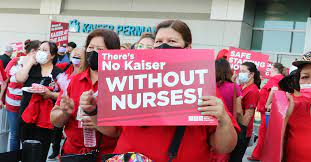Crisis Averted: The Kaiser Permanente Healthcare Worker Strike and Its Impact on Patients and Industry

In an unprecedented move, 75,000 dedicated healthcare professionals, including nurses, emergency department technicians, and pharmacists, have initiated a widespread strike across Kaiser Permanente hospitals and medical facilities nationwide. This massive walkout aims to draw attention to the critical staffing shortages that have been exacerbated by the ongoing COVID-19 pandemic. Let’s delve deeper into this historic healthcare workers’ strike and its implications for both patients and the healthcare industry.
The Unprecedented Strike
Over 75,000 healthcare workers took to the picket lines in California, Colorado, Washington, Oregon, Virginia, and Washington, D.C., marking the largest healthcare strike in U.S. history. Kaiser Permanente, headquartered in Oakland, California, is one of the nation’s leading nonprofit healthcare providers, serving nearly 13 million patients. Most of the striking workers will participate for three days, concluding on Saturday, with the exception of those in Virginia and Washington D.C., who will strike for 24 hours.
Impact on Patients
Kaiser Permanente has reassured patients that its hospitals and emergency departments will remain open throughout the strike, staffed by physicians and other essential personnel. The organization is also rapidly onboarding additional professionals to ensure critical care services are maintained during the strike. However, patients may experience rescheduled non-emergency and elective services during this time. To mitigate potential disruptions, Kaiser is expanding its network of pharmacy locations, including community pharmacies, to ensure continued access to medication in the event of temporary outpatient pharmacy closures. Inpatient pharmacies at Kaiser hospitals will continue to operate. Approximately 60% of Kaiser employees, including doctors, will remain on duty during the strike.
The Root Cause: Short-Staffing Crisis
This strike is the latest in a series of actions taken by essential workers demanding better work conditions and pay, following the footsteps of the Hollywood writers and United Auto Workers strikes. The healthcare workers’ walkout is fueled by a severe short-staffing crisis, which they argue has created challenging working conditions and made it increasingly difficult to retain Kaiser employees. Simultaneously, this crisis has adversely affected the quality of care provided to Kaiser’s patients. In April of this year, approximately 11% of union positions remained vacant, according to data obtained from Kaiser by the unions.
Caroline Lucas, the executive director of the Coalition of Kaiser Permanente Unions, emphasized that healthcare workers are passionate about their profession and see it as a calling. However, the current conditions have left them feeling unable to provide the best possible patient care.
Labor Dispute
The unions claim that Kaiser has engaged in unfair labor practices by not bargaining in good faith to address the staffing crisis. Kaiser, on the other hand, denies these allegations and has urged workers to refrain from striking to prevent harm to patients. However, employees like Brooke El-Amin, who has devoted 21 years to Kaiser, assert that patient care is already suffering due to staffing shortages. Their goal is to pressure Kaiser into improving patient care in the long run.
The Strike Unfolds
The strike began with pharmacists and optometrists in Washington D.C. and Virginia at 6 a.m. local time, followed by workers in Colorado and the West Coast. The picket lines at Kaiser’s Springfield Medical Center in Virginia were soon joined by dozens of Kaiser employees, driven by their union’s momentum.
Keyani Adigun, a clinical pharmacist in Washington D.C., recounted the challenges she faced throughout the pandemic as colleagues left Kaiser in large numbers. She pointed out that her employer still hasn’t provided sufficient resources, even after more than three years since the onset of COVID-19. Adigun expressed hope that Kaiser’s leadership would heed their voices.
Contract Negotiations and Demands
The collective bargaining agreement for employees represented by a coalition of unions expired on September 30, with no new agreement in place. While there has been progress on certain issues, such as outsourcing and subcontracting protections, key sticking points, including wages, remain unresolved. The coalition is requesting a nearly 25% pay raise for all members and improved benefits, including medical coverage for retirees. They argue that better pay and working conditions would incentivize employees to stay at Kaiser and attract new talent, ultimately addressing the staffing shortage.
Kaiser has countered with offers ranging from 12.5% to 16% pay increases over four years. The organization also aims to hire an additional 10,000 union workers by the end of 2023 to fill vacancies.
Kaiser asserts that staffing shortages and burnout are challenges affecting the entire healthcare industry, not exclusive to their organization. They emphasize that their compensation and benefits packages are among the best in the industry.
Caroline Lucas acknowledges that Kaiser’s efforts to increase hiring are a step in the right direction. However, she stresses that the company must take into account the ongoing exodus of workers and substantially raise wages to retain and attract the necessary talent.
In conclusion, the Kaiser Permanente healthcare worker strike has garnered significant attention as it underscores the critical issues surrounding staffing shortages in the healthcare industry. As negotiations continue, the outcome of this strike will likely have far-reaching implications for healthcare workers and patients alike.





